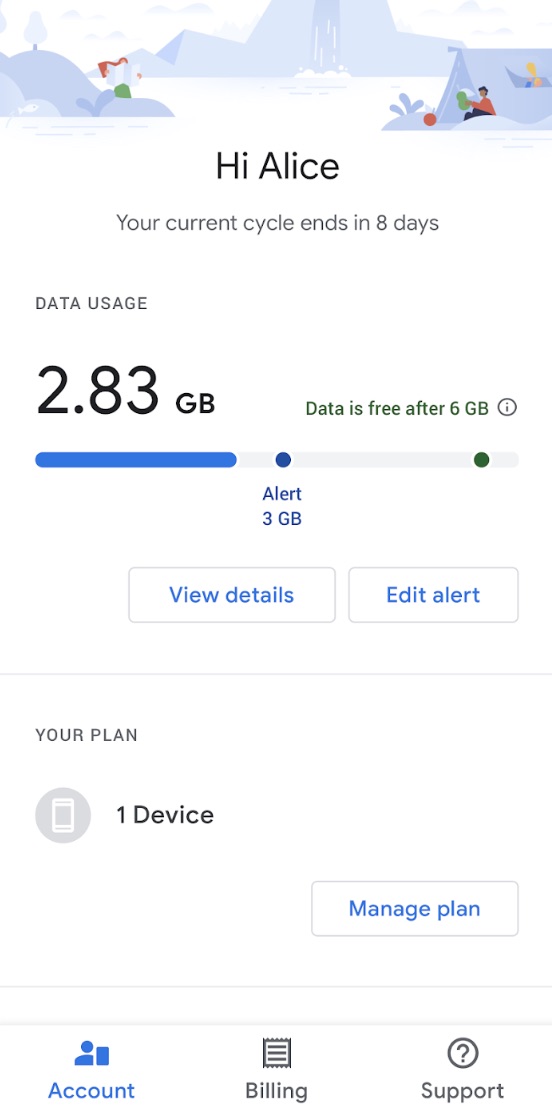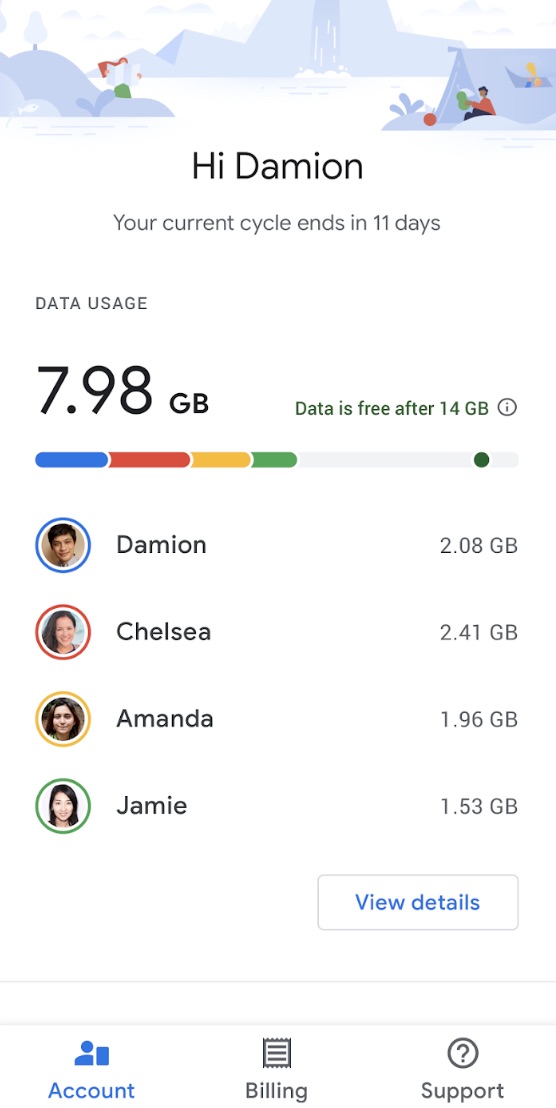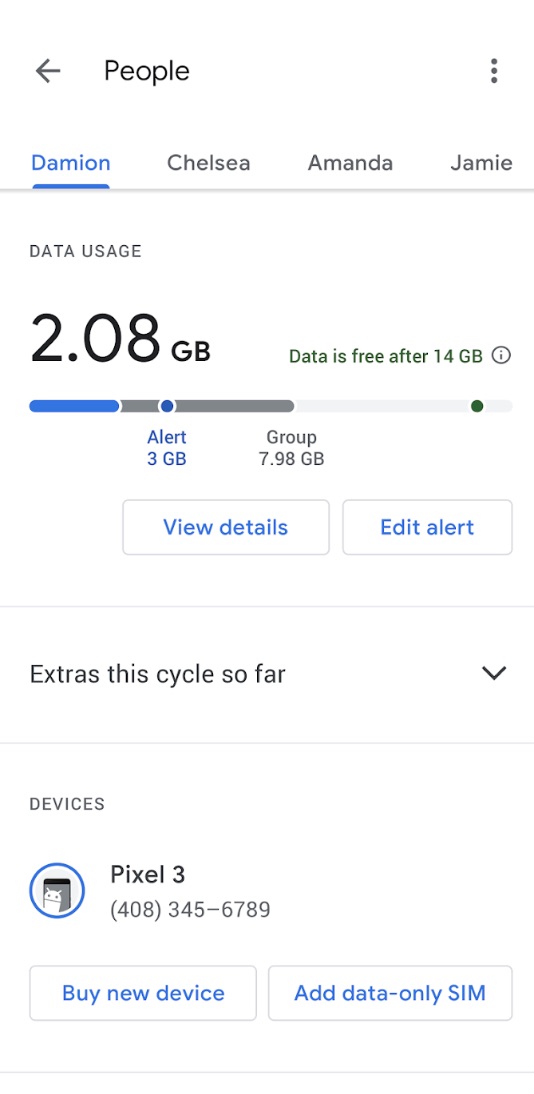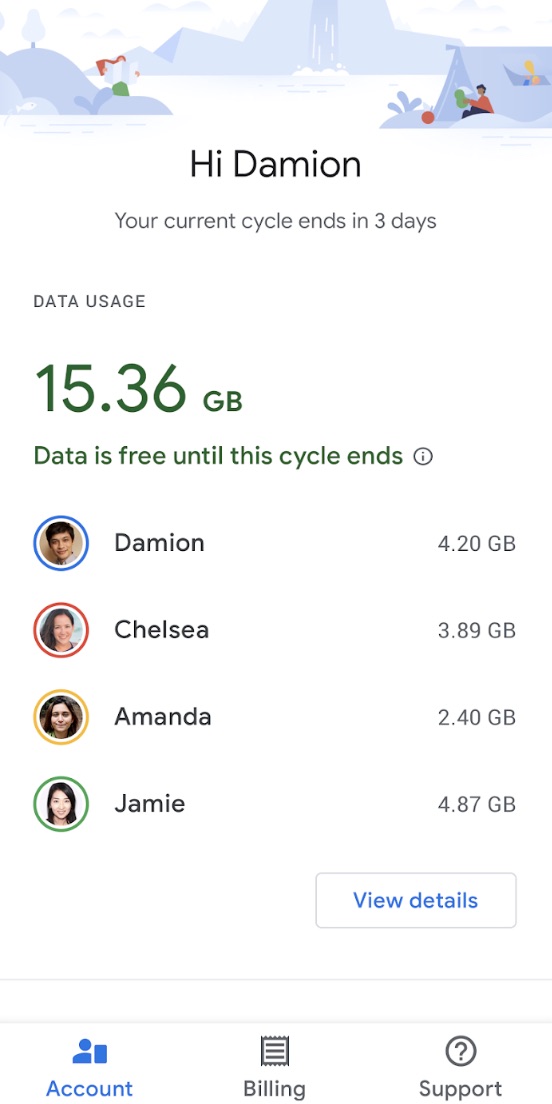In 2015, Google launched Project Fi, a mobile virtual network operator (MVNO) compatible with Nexus and Pixel smartphones (and the Motorola Moto X4). Three years later, the company announced the project had been brought directly under Google’s branding with a name change to “Google Fi.” Since then, Google’s MVNO has gone from strength to strength, and today, it is compatible with the majority of Android devices, and it even works with iPhones.
Here’s everything you need to know about Google Fi, including plan pricing, phones that are compatible with Google Fi, and more.
Google Fi at a glance
- What is Google Fi?
- Google Fi plans
- Google Fi phones and tablets
- How to switch to Google Fi
- How to contact customer service
- Google Fi and 5G
- Google Fi for the family
- Phone payment plans and trade-in program
What is Google Fi?
Google Fi offers data, voice, and texting services for a flat rate and boasts a robust network that reaches most of the contiguous U.S. It’s one of the few wireless carriers in the U.S. to refund you for the data you don’t use, meaning if you churn through 7.5GB of data in one month on a 10GB plan, you are credited the remaining 2.5GB. It also offers an unlimited data plan, which doesn’t offer the same pay-as-you-go setup, but might be better for those that use a lot of data.
Fi is also unique because its network relies on a combination of U.S. Cellular, T-Mobile, and Sprint for coverage, and compatible phones switch between the three depending on network congestion and signal strength. The carrier also offers support for RCS Chat, meaning customers will be able to send larger image and video files when texting, as well as premium messaging features like read receipts, typing indicators, and more. Best of all, unlocked phones that work on T-Mobile’s 5G network can also connect to 5G over Google Fi.
It’s easy to sign up for Google Fi too. Not only can you sign up through the Google Fi website, but now you can also head to Best Buy and get a SIM card off the shelf. The downside to that, however, is that you’ll pay $10 for the Best Buy SIM cards. When you sign up online, Google will ship the SIM card to you for free. You can also port your phone number from the existing service you use, rather than having to use a new one.
Importantly, Google Fi also has 5G support, and you can check your 5G coverage using Google Fi’s 5G coverage map. It uses T-Mobile’s 5G network, so make sure your phone supports that network. You can find a list of compatible models on Google Fi’s FAQ.
Google Fi plans
Google offers two plans as part of Google Fi: An Unlimited plan and a “Flexible” plan. The Flexible plan is Google Fi’s traditional plan, allowing users to pay for the amount of data they use at the end of the month. The new Unlimited plan, however, is probably better for those that use a lot of data each month and don’t want to have to worry about limiting their use.
Google Fi Unlimited
Google Fi has joined the ranks of carriers offering unlimited data plans, which is good news for those that use a lot of data each month. Here’s a breakdown of the costs associated with Google Fi’s unlimited data plans.
| People | Line cost | Total |
| 1 | $70 ($35 for the first 3 months) | $70 ($35 for the first 3 months) |
| 2 | $60 x 2 ($30 for the first 3 months) | $120 ($60 for the first 3 months) |
| 3 | $50 x 3 ($25 for the first 3 months) | $150 ($75 for the first 3 months) |
| 4 | $45 x 4 ($23 for the first 3 months) | $180 ($92 for the first 3 months) |
| 5 | $45 x 5 ($23 for the first 3 months) | $225 ($115 for the first 3 months) |
| 6 | $45 x 6 ($23 for the first 3 months) | $270 ($138 for the first 3 months) |
The Google Fi Unlimited Plan offers unlimited data, but like any unlimited data plan these days, there is some fine print. For example, you’ll get high-speed data for 22GB, but after you use up that allotment, your speed may be throttled. Not only that, but Google says video may stream at 480p. You can also opt to pay $10 per GB of data you use beyond the limit.
Still, as with other Google Fi plans, there are some great perks — especially for those who travel a lot. The Google Fi Unlimited plan offers free data and texting while traveling, and free calls to 50+ countries and territories. In other words, you’ll be able to just continue using your data the same way you otherwise would. There is a fee for international calling outside of those allowed territories though, and calls to those countries will cost you 1¢ per minute.
With the Unlimited plan, Google will also bundle a Google One subscription with 100GB of storage for each person on your plan. It’s not a huge saving, but it could be handy for those already using Google Drive.
Recommendations:
- Google Fi’s Unlimited plan is perfect for those who don’t want to have to worry about their data use during the month, or who plan to use a lot of data.
- The price of the Unlimited plan is pretty much on par with other carriers — and even cheaper in many cases — so it’s a solid option for heavy data users.
The perks of Google Fi Unlimited:
- Relatively inexpensive
- Good coverage
- Excellent international coverage
The downsides of Google Fi Unlimited:
- 480p video streaming
- Google One subscription not worthwhile if you’re already using another cloud storage service
Google Fi Flexible plan
If you don’t use all that much data or like the idea of only paying for the data that you use, then the Google Fi Flexible plan may be the way to go. Pricing for the Google Fi Flexible plan can be found below.
| People | Line Cost | Data Cost | Total |
| 1 | $20 | $10 per GB per user | $20 per month + data |
| 2 | $18 | $10 per GB per user | $35 per month + data |
| 3 | $17 | $10 per GB per user | $50 per month + data |
| 4 | $17 | $10 per GB per user | $65 per month + data |
| 5 | $16 | $10 per GB per user | $80 per month + data |
| 6 | $16 | $10 per GB per user | $95 per month + data |
But while Google Fi’s Flexible plan isn’t the cheapest, it comes with a lot of perks. Pricing starts at a flat $20 per month for unlimited calls and texting and $10 for 1GB of data, but money for unused data is credited back to the user’s account. Overages result in a charge of $10 per GB used. Google Fi also doesn’t levy a fee on mobile hot spots — data used while tethering is deducted from a user’s monthly allotment. In terms of pricing, Google Fi’s Flexible plan definitely isn’t the cheapest prepaid plan on the block. Republic Wireless, for example, offers talk, text, and up to 5GB of 4G LTE data for $40 per month — $30 per month cheaper than the equivalent Google Fi plan. Cricket Wireless’ $55 plan has unlimited talk, text, and data. FreedomPop’s 5GB tier starts at $35 per month.
Another perk is “Bill Protection,” which gives you unlimited data for $80 (if you only have one line). That’s because Google will no longer charge for more than 6GB of data — so if you use 10GB, you will still only be paying for 6GB. The caveat is that Google says users might experience slower speeds after 15GB of data. Bill Protection kicks in at different levels for group plans — and you can see where here. You should also be aware that the 6GB cap is for one-person plans. The cap increases to 10GB for two people, 12GB for three users, and 14GB for four people. Five- and six-person plans are capped at 16GB and 18GB, respectively.
Fi’s Group Plans let users add other people to their subscription for an additional $15 per user per month. Group Plans let plan managers view data usage by each member, set data notifications, add monthly allowances, and pause members’ data usage. A more recent feature, Group Repay, automatically calculates each of the members’ shares of the monthly bill and allows payments in fixed amounts based on an individual’s total usage, or only for data usage above the standard allotment.
Fi subscribers can use 4G LTE data in more than 135 countries around the world, including Denmark, France, Greece, Italy, Japan, Norway, Poland, Russia, Spain, and Turkey (see Google Fi’s support page for the full list of supported carriers and countries). International data costs the same rate as Google Fi data in the U.S., and text messaging is free. Calls start at 20 cents per minute.
Recommendations:
- Google Fi’s Flexible plan can be a good option for those who don’t use a lot of data but still want the option to use a lot down the line. If you consistently use more than 6GB of data, then the Unlimited plan data plan might be better for you.
The perks of Google Fi Flexible:
- Strong service in rural areas
- Savings for light data users
- High-speed international data at no extra charge
- Tethering at no extra charge
- Bill Protection caps your bill
The downsides of Google Fi Flexible:
- Pricier plans than T-Mobile, Sprint, AT&T, and Verizon, and some MVNOs, depending on the data allotment
Google Fi phones and tablets
Since Google Fi’s network-switching technology requires special software and wireless radios, you’ll get the full experience with a phone that’s designed for the service. Google Fi-compatible phones also take advantage of Wi-Fi Assistant, a background service that automatically connects to “more than a million” public hotspots. It’s a seamless transition between the networks — calls aren’t interrupted when the phone switches from cellular to Wi-Fi — and the connection is secured through a virtual private network that routes traffic through Google’s servers.
Google Fi phones are designated as “designed for Fi.” They all come with support for calling, texting, and data over multiple 4G LTE networks, automatic connection to Wi-Fi hotspots, international roaming, and support for Fi VPN. You can find the full list of supported devices below:
- Samsung Galaxy S21 5G
- Samsung Galaxy S21 Plus 5G
- Samsung Galaxy S21 Ultra 5G
- Samsung Galaxy S20 5G
- Samsung Galaxy S20 Plus 5G
- Samsung Galaxy S20 Ultra 5G
- Samsung Galaxy Note 20 5G
- Samsung Galaxy Note 20 Ultra 5G
- Samsung Galaxy A71 5G
- Pixel 5
- Pixel 4a 5G
- Pixel 4a
- Pixel 4
- Pixel 4 XL
- Pixel 3a
- Pixel 3a XL
- Pixel 3
- Pixel 3 XL
- Pixel 2
- Pixel 2 XL
- Pixel
- Pixel XL
- LG V35 ThinQ
- LG G7 ThinQ
- Motorola One 5G Ace
- Motorola Moto G Stylus
- Motorola Moto G Power (2021)
- Motorola Moto G Power (2020)
- Motorola Moto G Play
- Motorola Moto G7
- Motorola Moto G6
- Motorola Moto X4 (Android One)
- Nexus 5X
- Nexus 6P
- Nexus 6
If you use an iPhone or Android smartphone that’s not listed above, you’ll still have the same data coverage (including international coverage) and access to the same group plans. These phones just won’t get the network switching technology (so you’ll be stuck on one network, specifically T-Mobile), and there is no access to the Fi VPN to secure your connection. You’ll still be able to see members on your plan and data usage — whether on the iOS or Android app — and have access to 24/7 customer support and more. It should be noted visual voicemail is not supported on the iOS app at the moment.
You can check whether your current phone works by checking Google Fi’s compatibility page.
Google Fi works with more than just smartphones, but it’s not quite the same experience. A data-only SIM that lacks calling and texting features works on select iPad models and Android tablets; Google Fi subscribers can add up to nine data-only SIMs to a single plan.
You can find the specifics on whether your tablet will work on Google Fi by checking out the Google Fi FAQ.
How to switch to Google Fi
Thinking of switching to Google Fi? The good news is you can use Google Fi with your existing number so you don’t have to go through the hassle of sharing new contact details. Follow the steps below to complete the process.
- Visit the Google Fi website.
- Enter the information about your current plan.
- Insert the SIM card (devices like the Pixel 2 and later don’t need to perform this step as they can use an eSIM).
- Set up your phone like you would on any new device.
- Check the status of your transfer on the Google Fi app or the official website.
- Look for a notification to alert you of the transfer process completing.
- Wait for a while until all features are fully functional and you’re ready to use Google Fi.
How to contact customer service
Ran into some trouble while setting up Google Fi? Want to leave a complaint or feedback? You can easily contact their customer service through the Help Center. The homepage is divided into multiple topics, so you can quickly navigate to the page covering tips and solutions for your problem. Each section is further divided into multiple specific subsections covering all the common problems users face, from signing up to Google Fi to billing issues.
If you’re not satisfied with the solutions provided in these guides, take a look at the community center to interact with other users who have faced similar problems. If all else fails, you can directly contact customer service representatives by visiting their Contact Us page.
Google Fi and 5G

The fifth generation of mobile networks is coming, and many manufacturers are hyping up their upcoming 5G-enabled phones. But all of that means nothing if the networks aren’t also capable of putting out a 5G signal for those phones.
Google Fi customers may have been worried their network would take a while to get access to the fifth-generation mobile network, but Google Fi 5G is upon us. Sprint has its 5G network up and running in nine major U.S. cities: Atlanta, Chicago, Dallas, Houston, Kansas City, Los Angeles, New York City, Phoenix, and Washington, D.C. The service works with some of today’s most popular phones, including Samsung Galaxy Note 10+ 5G and the OnePlus 7T Pro 5G McLaren. But since they’re not designed for Google Fi, they won’t offer network-swapping.
Google Fi for the family
Google Fi also offers parents the option of managing their kids’ data usage, and with the Family Link app, you can manage the content that your children see — at least insofar as their apps are concerned. You can set some ground rules for your children — whether they’re younger or teenagers — by limiting screen time, or locking your children’s phones when it’s bedtime, homework time, or mealtime. Parents can also set filters in Chrome, search, and other Google services to protect their children from online dangers and encourage them to explore and learn about the internet in a safe way.
You can not only manage the apps they use, but you can also view your children’s online activity to spark conversations about what’s appropriate for them and what’s not. With location services, you can even see where your child is when they’re out and about.
Phone payment plans and trade-in program
Google Fi compatible smartphones are no longer confined to the most expensive flagships, but there are still a few things you can do to help bring costs down. If you trade in your current cell phone, you could receive a hefty amount of credit at the Google store. To see if you’re eligible for the trade-in program, check out the Google Store’s Terms and Conditions online, or browse the full list of Google Fi phones.
Users also have an option to opt for the monthly financial installment plan with 0% interest. That allows users the chance to pay back the Google Fi service for up to 24 months. If at any point in those two years, you’re able to pay off the remaining balance for your Google Fi plan, you can do so without repercussion.
At the moment Google is offering the excellent Pixel 4a at just $15/month, with device protection and an upgrade after two years. That’s a strong deal, and one worth looking into if you want a good phone with all of Google Fi’s features.





